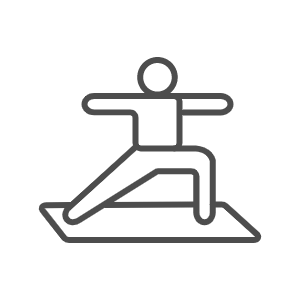
NEW In!
PURE-Matte Light TaupeShopping cart
Your shopping basket is empty
Free shipping from €39
Produced Ecologically & Fair
For All Yoga Styles
Yoga

Meditation
Sets & Bundles
The origins of Ayurveda and Yoga can be found in the Vedic scriptures and contain insights into the connections of life, which were revealed by sages and seers in deep meditation. The Vedic scriptures consider the human being holistically and connect body, mind and soul as a part of the whole cosmos .

The word Ayurveda is made up of Ayur = life and Veda = knowledge and therefore means "knowledge of life". Ayurveda encompasses all of science and wisdom, including natural science, and focuses on health care and the treatment of illnesses and complaints.
Yoga and Ayurveda originated in India around 3000 years ago and are both practices and holistic healing methods based on introspection and experience. For thousands of years, the valuable teachings of Yoga and Ayurveda have brought harmony and harmony back into human physical and mental well-being. Both in yoga and in Ayurveda, great value is placed on a conscious, extremely mindful and ethical lifestyle, which intensively trains the mind and in which one treats one's body and one's own breath carefully through observation, reflection and fine self-awareness.
The basis of prevention and therapy in Ayurveda is the determination of the individual constitution (Prakriti) and any existing disorders (Vikriti). Because every person is unique in terms of their constitution (Dosha) and characteristics. Anyone who knows their dosha type and their individual characteristics knows in which areas their strengths and weaknesses lie and can assess which yoga practice, nutrition or meditation technique is effective and healing. Ayurveda teaches people the valuable art of living and shows ways to be healthy and efficient, but above all to be content and balanced.
It offers methods and formulas to correct an imbalance before a disease occurs and to alleviate and heal existing ailments. Since a regular yoga practice, ideally adapted to one's own constitutional type, is of great importance in Ayurveda, this also applies to the diverse meditation techniques. Meditation is the essential basis of every spiritual practice and can be adapted to your own dosha type, as can nutrition or yoga asanas, giving you deeper experiences but also easier access to your inner world and your healing path.
The Ayurvedic scientists tried to explain the complicated processes in nature in a clear and simple way, which resulted in the well-known tri-dosha system.
The many different properties are summarized in the large elements space, wind, fire and earth :
Space: light, fine, clear, permeable
Wind: agile, light, clear, dry, rough, penetrating
Fire: hot, light, mobile
Water: liquid, cold, soft
Earth: heavy, stable, dense, hard, immobile
These elements of Ayurveda do not correspond to the chemical elements we are familiar with, but rather symbolize specific qualities in nature. The properties of the major elements can be found in the 3 body and bio energies (Doshas):
Vata (space and wind) , Pitta (fire and some water) and Kapha (water and earth)
The 3 doshas are therefore responsible for all processes in nature and in humans and their basic functions are creation, transformation and destruction. These doshas determine the biological, physiological and psychological functions of the human body and consciousness, they shape the external appearance as well as the physical and psychological characteristics of a person.
Vata Dosha is described as a moving force and controls degradation and destruction, it has the properties of the elements of space and wind. The function of the Vata Dosha in the body corresponds to our entire nervous system and controls all movements, breathing, blood circulation, excretory and sensory organs and controls our consciousness.
If the Vata dosha is increased, this is reflected in nervousness, restlessness, insomnia, migraines and pain syndromes, etc. In the case of a Vata Vikriti (Vata disorder), a Vata-reducing practice is recommended, in which you will find more inner peace and stability .
A Vata Vikriti, for example, can also manifest itself as a state of "floating in the clouds," so grounding and warmth are important. Grounding meditations and the visualization of deep, grounding roots are very helpful in reducing Vata. A balanced Vata person is light, agile and fast, but above all the Vata type is very active mentally and creatively and has a rich inner treasure of ideas that want to be carried out into the world.
Pitta Dosha is the heat-generating power and is responsible for transformation processes and bears the properties of the elements fire and water. Pitta also regulates the metabolic processes in the body and regulates body temperature and controls our feeling of hunger and thirst. Pitta is responsible for courage, perseverance, intelligence, controlling emotions and spreading knowledge. All those inner images and visualizations that give more peace and above all "cooling down" help the Pitta - people to achieve an inner balance without burning out. The transforming and sensual qualities of the fire element can thus be used in a healthy and sustainable way, e.g. for creative self-expression, the fire element is elevated, so general irritability can set in and the body may also struggle with inflammation has. For a Pitta-reducing practice, the visualization of the inner axis, the moon in the forehead and a heart meditation are recommended to bring Pitta back into harmony.
Kapha Dosha: is the cohesive, stabilizing force and responsible for structure and stability in nature and includes the properties of water and earth. In the body, Kapha is responsible for cohesion and stability in tissue, organs and the whole body. It provides strength, calmness and patience, resistance and joie de vivre.
An excess of Kapha is expressed, for example, by water retention, sluggishness and sluggishness. It is good for a Kapha Vikriti to slightly increase Fire and Air and reduce the elements of Water and Earth. The Kapha type could, for example, practice Kapalabhati - fire breathing - before meditating or practicing yoga and generally pay attention to activating exercises. A visualization of fire through the Tratak meditation nourishes the inner kapha-type fire and creates more energy flow and activity. A person whose constitution is the Kapha dosha has great strength and stability, which makes them extremely resilient and hardly susceptible to stress. The Kapha type, undisturbed, is self-contained without becoming sluggish.

The days are long again in summer and we enjoy the lightness of summer and the beautiful summer nights. From an Ayurvedic point of view, the time ...
Continue reading
In our previous blog post you have already received many useful insights into the world of Ayurveda and now you know what it is all about. Accordi...
Continue reading